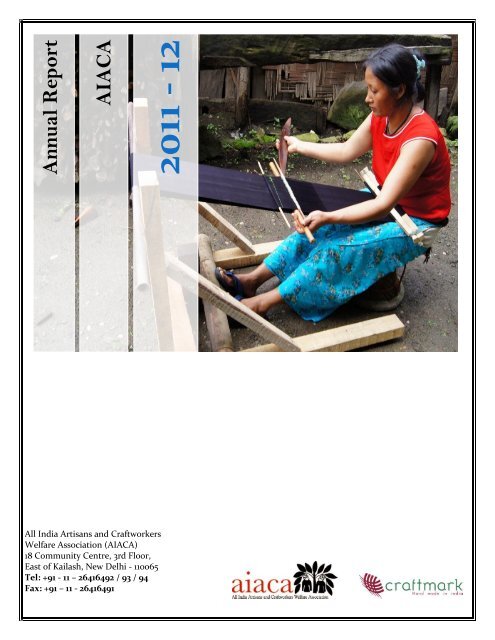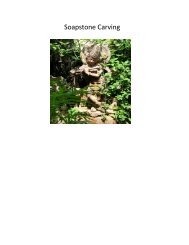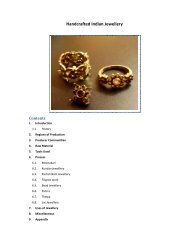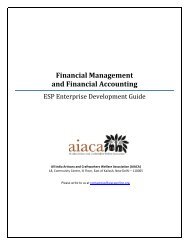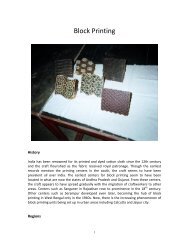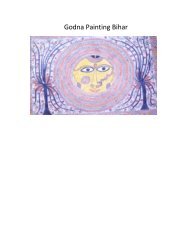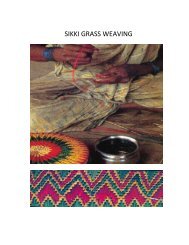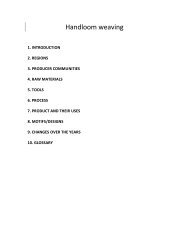Download Pdf - All India Artisans and Craftworkers Welfare ...
Download Pdf - All India Artisans and Craftworkers Welfare ...
Download Pdf - All India Artisans and Craftworkers Welfare ...
Create successful ePaper yourself
Turn your PDF publications into a flip-book with our unique Google optimized e-Paper software.
Annual ReportAIACA2011 - 12<strong>All</strong> <strong>India</strong> <strong>Artisans</strong> <strong>and</strong> <strong>Craftworkers</strong><strong>Welfare</strong> Association (AIACA)18 Community Centre, 3rd Floor,East of Kailash, New Delhi - 110065Tel: +91 - 11 – 26416492 / 93 / 94Fax: +91 – 11 - 26416491
P a g e | 2Table of ContentsED’s Note.................................................................................................................................................03About AIACA..........................................................................................................................................04Policy Research <strong>and</strong> Advocacy (Summary of Projects 2011 -12) ..........................................................06Enterprise Support Program (Summary of Projects 2011 -12)...............................................................11Craftmark /Marketing (Summary of 2011 -12)........................................................................................14Governing Body of AIACA………………………………………………………………………………………………………………16Information about AIACA......................................................................................................................18Financial Statements.................................................................................................................. …………19ANNUAL REPORT 2011 - 12
P a g e | 3ED’s NoteIt gives me pleasure to place before you the Annual Report of the <strong>All</strong> <strong>India</strong> <strong>Artisans</strong> <strong>and</strong><strong>Craftworkers</strong> <strong>Welfare</strong> Association (AIACA) for the year 2011-2012.In 2010-2011, though the exports of h<strong>and</strong>crafted goods exceeded Rs 10,000 crores, yet theh<strong>and</strong>loom census carried out showed that the sector is composed of people largely fromvulnerable classes <strong>and</strong> low socio-economic indicators, the facts testifying both to the potential<strong>and</strong> the challenges facing this sector.AIACA’s work focus on the welfare of the individual artisan <strong>and</strong> the growth of the sector, <strong>and</strong> itsinterventions cuts through the capacity building of enterprises to br<strong>and</strong> building <strong>and</strong> research,directed at bringing about crucial changes in policies for this sector.Over 2011-2012, AIACA took its policy work forward through formal submissions on Environment<strong>and</strong> Occupational Health <strong>and</strong> Safety to the Ministry of Textiles <strong>and</strong> the Planning Commission of<strong>India</strong>, for inclusion in the approach paper to the Twelfth Five Year Plan. AIACA also grew in termsof exp<strong>and</strong>ing its network strength, increasing the number <strong>and</strong> value of market linkages providedto its members, <strong>and</strong> enhancing fee based income for itself. Internally, it focused on streamliningoperations <strong>and</strong> policies so as to build an apex organization with increased capacity to addressneeds of its members. Over the next few years, AIACA intends to scale up its existing programmes<strong>and</strong> enhance the impact it makes on the economic <strong>and</strong> social lives of artisans.Specific initiatives in the Policy Research <strong>and</strong> Advocacy area as well as the details of thepartnerships developed under its core programmes have been included in the various sections ofthe annual report.Thanks are due to the AIACA Board members as well as its team for the committed work put inby them.Please feel free to write in with any comments that you may have on this report or AIACA’s workat amita@aiacaonline.orgANNUAL REPORT 2011 - 12
P a g e | 4ABOUT AIACAThe h<strong>and</strong>loom <strong>and</strong> h<strong>and</strong>icraft sector represent an importantsource of livelihood in <strong>India</strong>, especially in the rural areas.Being the second largest employer in rural <strong>India</strong>, manyagriculture communities depend on it as secondary source ofincome generation activity during time of drought, leanharvests <strong>and</strong> famines. Despite a significant contribution to thenational GDP <strong>and</strong> export earnings, little effort has been madeto enhance the income of craftworkers at the macro level.AIACA was established in 2004 to serve as an apex body tobring together a wide range of players in the h<strong>and</strong>loom <strong>and</strong>h<strong>and</strong>icraft sectors <strong>and</strong> to ensure a collective action to ensuremarket-led growth of these sectors <strong>and</strong> the better st<strong>and</strong>ard ofliving for the artisans <strong>and</strong> craftworkers. AIACA is unique inbringing together both civil society <strong>and</strong> private businesses onthe same platform <strong>and</strong> engage with government to spurenterprise growth in the crafts sector. AIACA has reached aVISION / MISSIONAIACA seeks to represent a rangeof organization in h<strong>and</strong>loom <strong>and</strong>h<strong>and</strong>icraft sectors, <strong>and</strong> to engagein policy advocacy activity aimedat increasing the domestic <strong>and</strong>international market forh<strong>and</strong>loom <strong>and</strong> h<strong>and</strong>icraftproducts along with improvingthe st<strong>and</strong>ard of living of craftworkers <strong>and</strong> to explore new <strong>and</strong>commercially sustainable modelsof livelihood promotion.membership of more than 100 organizations through its three tiered membership program.Through its research on issues critical to the welfare of artisans <strong>and</strong> the growth of the sector,AIACA has carved spaces for policy advocacy over the years. It has conducted studies on Access toCredit, Status of H<strong>and</strong>loom Cooperatives, Environment, Occupational Health <strong>and</strong> Safety issues inthe crafts sector <strong>and</strong> case studies on successful producer groups. Policy Inputs in the 12 th <strong>and</strong> 11 thNational Five Year Plans were provided as a member of the Working Group on Textiles, JuteVillage <strong>and</strong> Small Enterprises. In 2007, AIACA provided formal inputs to the Prime Minister'sConsultation on H<strong>and</strong>loom Policy. Currently, it plays an advisory role in various policy arenas,especially the two nodal bodies relating to the sector: the Planning Commission <strong>and</strong> the Ministryof Textiles. One of the key lacunas in the crafts sector, especially for producer groups <strong>and</strong> smallentrepreneurs located in rural areas, is that despite the commercial potential of the product itself,such groups are not able to access the knowledge <strong>and</strong> professional expertise required to scale uptheir operations.In 2008, AIACA initiated an Enterprise Support Program (ESP)to provide capacity building services to craft producer groupsthat help mobilize resources, institute specific business systems,build capacity (through short <strong>and</strong> long term interventions) <strong>and</strong>scale up operations. Under its ESP, AIACA chooses producergroups <strong>and</strong> clusters on a competitive basis <strong>and</strong> through aninitial feasibility analysis, analyzes their operations <strong>and</strong>ANNUAL REPORT 2011 - 12
P a g e | 6POLICY RESEARCH AND ADVOCACY (Summary of Project 2011 – 12)The Policy Research & Advocacy team supports the in depth research, community outreach,regulatory framework analysis <strong>and</strong> advocacy programme at AIACA. It also communicates withvarious stakeholders <strong>and</strong> conducts a regular dialogue through its quarterly newsletter – ’CraftPolicy Connect’.During 2011 – 2012, the primary focus of Policy Research & Advocacy was on promoting thesustainable production <strong>and</strong> consumption in the textiles sector. This was carried out under the‘Sustainable Textile for Sustainable Development’ project implemented under the EuropeanUnion’s Switch Asia Program. The project aims to promote the production <strong>and</strong> consumption ofeco friendly textiles by improving the working <strong>and</strong> living condition of the artisans throughpiloting <strong>and</strong> testing effluent treatment plants, undertaking research, <strong>and</strong> capacity buildingtrainings, <strong>and</strong> most importantly the dissemination, <strong>and</strong> outreach of the learning etc. which alsohelped in identifying the key challenges being faced by the sector.The m<strong>and</strong>ate of the project covers 16 craft clusters & 30 textile parks across <strong>India</strong> <strong>and</strong> extends itsbenefits to over 500 textile related M/SMEs in Rajasthan by sharing learning for replications.Activities <strong>and</strong> Strategies adopted under the programmeAwareness raising, capacity building <strong>and</strong> policy research have been used as primary strategies topromote the program’s m<strong>and</strong>ate.Partnerships for Sustainable Consumption <strong>and</strong> ProductionThe project brings together a range of partners - including technical service providers, textileproducer groups <strong>and</strong> M/SMEs to conduct action research to provide low cost technologicalsolutions to reduce pollution from textile production activities.Strengthening Cleaner production <strong>and</strong> OccupationalHealth <strong>and</strong> SafetyThe project works with textile units that rank among theworst polluting <strong>and</strong> resource intensive industries <strong>and</strong>addresses the issues through trainings, disseminationworkshops, which has promoted the use of environmentallyfriendly technologies <strong>and</strong> practices by the textile-producingSmall <strong>and</strong> Medium Enterprises.ANNUAL REPORT 2011 - 12
P a g e | 7Examining dem<strong>and</strong> for textilesOn the dem<strong>and</strong> side, the project encourages effective marketing strategies to promoteenvironment friendly textiles. It seeks to promote environment friendly practices which furtherimpacts consumers’ choice/buying decisions, leading to sustainable consumption throughdissemination at trade fare <strong>and</strong> others shows.Policy Research <strong>and</strong> AdvocacyThe project conducted a baseline study to assess environmental, occupational health <strong>and</strong> safetyissues (OHS) <strong>and</strong> provided recommendations to the Planning Commission of <strong>India</strong> in 2011-2012based on its results of the baseline. These recommendations have been incorporated in the Draft12 th Five Year Plan prepared by the Working Group.Replication StrategyBuilding a model ready to replicateUnder the project, a model eco-friendly textile park is being established at Jaipur under thepublic-private partnership between the Government of <strong>India</strong> <strong>and</strong> textiles manufacturers’ thatprovides funding for the infrastructure. The project provides research, knowledge to theentrepreneurs <strong>and</strong> through it builds the capacities of the entrepreneurs <strong>and</strong> workers under thismodel. The public-private partnership ensures the acceptance of the eco-park model. The keyproject strength is the buy-in of the Jaipur Integrated Textile Park Pvt. Ltd. members.ResultsOutreach ensuredThe project enhances its benefits to 16 other craft clusters in <strong>India</strong> <strong>and</strong> over 500 textile relatedSMEs in Rajasthan where block printing is predominant; craft-clusters have benefited fromresearch on low cost technology, specifically occupational health <strong>and</strong> safety measures, sharing oflearning <strong>and</strong> opportunities for replication. During 2011-2012, 3500 M/SMEs have participated indissemination activities under the project.Data for Decision makingA baseline study assessed the environmental, occupational health <strong>and</strong> safety (OHS) issues <strong>and</strong>their impacts on the local communities. The study incorporated field visits, data collection,testing of samples, surveys <strong>and</strong> focused group discussions to flag the main issues of the sector.The study was discussed widely by the various stakeholders. The project prepared a manual onOHS for the <strong>Artisans</strong> <strong>and</strong> conducted dissemination workshops in more than 16 clusters. Themanual provides recommendations for SMEs <strong>and</strong> artisans on OHS measures during production,contributing to sustainable production practices.ANNUAL REPORT 2011 - 12
P a g e | 8Market researchThe project also conducted Market Research, reviewed the st<strong>and</strong>ards for environment friendlyproducts <strong>and</strong> the market potential of such products within <strong>India</strong> <strong>and</strong> beyond. The studies laid thegroundwork for formulating effective marketing strategies for eco-friendly products in domestic<strong>and</strong> international markets. To help the manufactures respond to increasing dem<strong>and</strong> for greenproducts, a market dissemination workshop was conducted to sensitize entrepreneurs aboutdesign, pricing, st<strong>and</strong>ards of the eco-friendly products.Br<strong>and</strong>ing paves the way for organic textilesResearch revealed 70 different certification schemes available for textiles. Due to the high cost ofsuch labels, the textile manufactures instead developed an umbrella br<strong>and</strong> named Jaipur Blocduring the year that communicates the positiveRecommendations onEnvironmental issues - H<strong>and</strong>icraftsaspects <strong>and</strong> environmental friendliness of the park<strong>and</strong> the textiles produced in the park. The br<strong>and</strong>connects the producers to the consumers.Support for environmental review ofcraft processes <strong>and</strong> corrective measuresshould be made a part of existingschemes, especially the BabasahebAmbedkar Hastshilp Vikas Yojana(BAHVY). Diagnostic studies under theBAHVY scheme should include asection on environmental impact <strong>and</strong>interventions should include strategiesto mitigate adverse environmentalimpact, wherever applicable.The main intervention needed in thisarea is further research in the form ofreviews of selected crafts processes toascertain environmental impact; <strong>and</strong>research into low-cost solutions <strong>and</strong>changes in production processesneeded to mitigate adverse impactwhere it exists. A draft budget forresearch into 20 selected craftproduction processes – which can bechosen, based on commercial potential<strong>and</strong> number of artisans affected wasprovided.Policy workSubmissions to Government <strong>and</strong> IndustryTaking the policy work forward, formalsubmissions on Environment <strong>and</strong> OccupationalHealth <strong>and</strong> Safety for H<strong>and</strong>icrafts <strong>and</strong> H<strong>and</strong>loomswere provided to the Ministry of Textiles <strong>and</strong> thePlanning Commission of <strong>India</strong> for inclusion in theapproach papers to the Twelfth Five Year Plan. TheExecutive Director of AIACA, Kirtika Singh, asmember of the Steering Committee on H<strong>and</strong>looms<strong>and</strong> H<strong>and</strong>icrafts of the Planning Commission of<strong>India</strong> was a part of the development of approachANNUAL REPORT 2011 - 12
P a g e | 9papers for the 12th Five Year Plan.Recommendations onEnvironmental issues – H<strong>and</strong>loomsEnvironmental impact needs to beinserted as an area of focus intoexisting schemes, especially theIntegrated H<strong>and</strong>loom DevelopmentScheme. Diagnostic studies shouldinclude a section on environmentalimpact <strong>and</strong> interventions as part of thescheme should include strategies tomitigate water use <strong>and</strong> discharge ofuntreated wastewater.Two pilot schemes need to beintroduced to mainstreamenvironmental concerns <strong>and</strong> mitigationstrategies in the h<strong>and</strong>loom sector:A primary Effluent Treatment Plant costsapproximately Rs. 4 - 5 lakh. However, thistreatment would only neutralize water <strong>and</strong> will notbe useful for units with high effluent content. Asecondary/tertiary Effluent Treatment Plant wouldbe needed for larger MSMEs clusters, which costsapproximately Rs. 12-15 lakhs. The secondarytreatment, depending on the technology used, cantreat discharge of various kinds of dyes (vat,reactive, natural etc).The pilot scheme can seek to support a mix ofprimary <strong>and</strong> secondary treatment plans in selectedclusters based on the environmental assessment <strong>and</strong>the amount of discharge that needs to be treated.With regard to scheme eligibility, individual unitscan be eligible to receive scheme support forprimary treatment plants; <strong>and</strong> cluster levelassociations, cooperatives <strong>and</strong> large enterprises canbe eligible for setting up secondary treatmentplants. Based on an estimate of 15 selectedh<strong>and</strong>loom clusters, the cost estimate of the schemewas provided.Scheme for Environmental Assessmentsof Major Textile Clusters: A pilotscheme to conduct environmentalassessments of up to 15 selected majorh<strong>and</strong>loom clusters can be introduced.The scheme should support technicalagencies in carrying out environmentalassessments that identify <strong>and</strong> quantifyenvironmental impact <strong>and</strong> proposespecific mitigation strategies at thecluster level. A proposed costing ofsuch a pilot scheme for 15 clusters wasprovided.Scheme for Setting up of Small-scaleEffluent Treatment Plants in H<strong>and</strong>loomproducer communities: A pilot schemeto promote effluent treatment in majorh<strong>and</strong>loom production clusters needs tobe initiated. The scheme shouldsupport capital costs of setting up aneffluent treatment plant (ETP) as wellas costs associated with mobilizingsmall-scale units to use commoneffluent treatment facilities.ANNUAL REPORT 2011 - 12
P a g e | 10Recommendations on OccupationalHealth <strong>and</strong> Safety –H<strong>and</strong>icraftOccupational Health <strong>and</strong> Safety needsto be inserted as an area of focus intoexisting schemes, especially theBabasaheb Ambedkar Hastshilp VikasYojana (BAHVY) <strong>and</strong> the TechnologyUpgradation Scheme (TUS). Diagnosticstudies should include a section onhealth impacts, <strong>and</strong> interventions aspart of the BAHVY scheme shouldinclude strategies to mitigate suchharmful impact, including awarenesscampaigns; support for retrofitting ofwork-sheds with proper lighting <strong>and</strong>ventilation; <strong>and</strong> distribution of low-costsafety equipment kits. Under the TUS,support can be provided for improvingspecific craft production processes tominimize adverse health impacts <strong>and</strong>to introduce <strong>and</strong> field-test appropriateprotective gear. Safety pamphlets <strong>and</strong>protective equipment developedthrough research (see below) can thenbe made a part of ongoing schemeinterventions in selected clusters.During the 12th plan period, support isneeded to conduct more research toidentify <strong>and</strong> quantify health impacts inselected crafts clusters. The Office ofthe DC H<strong>and</strong>icrafts should seek tocommission studies into selected craftsclusters to identify <strong>and</strong> quantifyadverse health impacts <strong>and</strong> to furtherdevelop appropriate solutions. Initially,10 crafts clusters can be chosen basedon number of artisans employed <strong>and</strong>market potential of the craft.Recommendations on OccupationalHealth <strong>and</strong> Safety –H<strong>and</strong>loomsOccupational Health <strong>and</strong> Safety needsto be inserted as an area of focus intoexisting schemes, especially theIntegrated H<strong>and</strong>loom DevelopmentScheme <strong>and</strong> the TechnologyUpgradation Fund Scheme. Diagnosticstudies should include a section onhealth impacts, <strong>and</strong> interventions aspart of the scheme should includestrategies to mitigate such harmfulimpact, including awarenesscampaigns; support for retrofitting ofwork-sheds with proper lighting <strong>and</strong>ventilation; <strong>and</strong> distribution of low-costsafety equipment kits.During the 12th plan period, support isneeded to conduct more research toidentify <strong>and</strong> quantify health impacts inselected h<strong>and</strong>loom clusters. The Officeof the DC H<strong>and</strong>looms should seek tocommission studies into selectedh<strong>and</strong>loom clusters to identify <strong>and</strong>quantify adverse health impacts <strong>and</strong> tofurther develop appropriate solutions.Details & Factsheet of the project can be downloaded from www.switch-asia.eu <strong>and</strong> www.aiacaonline.orgANNUAL REPORT 2011 - 12
P a g e | 11ENTERPRISE SUPPORT PROGRAM (Summary of Project 2011 – 12)The Enterprise Support Program (ESP) provides consulting services to crafts producer groups tohelp them institute specific business systems <strong>and</strong> scale up their operations. The initiative executesits projects broadly under three categories: those of: consulting services (both long term <strong>and</strong> shortterm), capacity building, design workshops <strong>and</strong> skills trainings <strong>and</strong> marketing support. Thefollowing detail the partnerships undertaken over the year under this programme.ChitrikaChitrika promotes self-managed <strong>and</strong> self-sustaining institutions of artisans. Chitrika has beenworking on the apparel vertical, with the necessary processes such as internal managementsystems, appropriate bank linkages <strong>and</strong> quality assessment parameters <strong>and</strong> monitoring to ensureefficient production <strong>and</strong> delivery. The organization currently aims to exp<strong>and</strong> its existing range byintegrating the home furnishing production. ESP is working with Chitrika to assist on the newhome range design development.INTACH Jammu & KashmirINTACH's (<strong>India</strong>n National Trust for Art <strong>and</strong> Cultural Heritage – a nationwide not-for-profitmembership organization) Jammu & Kashmir Chapterprovides services to specific aspects of culturalheritage, conservation initiatives <strong>and</strong> management ofurban renewal in the Jammu & Kashmir State.Currently, the team is focussed on developing twoartisan clusters engaged in wicker weaving <strong>and</strong> crewembroidery in the Vasik Nag area. ESP is supportingINTACH Jammu & Kashmir with cluster incubation;organizational development <strong>and</strong> market connect forartisans.Rehwa SocietyRehwa Society is a not-for-profit foundation involved in production of Maheshwari textiles thatsupports a school, a housing program <strong>and</strong> several health services for weavers <strong>and</strong> families. Withmore than 120 weavers, Rehwa concentrates on weaving fashion textiles for traditional <strong>India</strong>nsaris <strong>and</strong> salwar kurtas, <strong>and</strong> fine home furnishings for both the domestic <strong>and</strong> internationalmarkets. ESP has engaged with them for a legal transition to a more sustainable <strong>and</strong> commercialmodel (proposed models evaluation is under progress with several discussions with involvedstakeholders in the existing setup). ESP is also engaged with them to revive their MaheshwariClassic collection.HAO CraftLocated in Delhi <strong>and</strong> Ukrul, Hao Craft society works with young artisans from Manipur makingBlack pottery called 'longpi' in Manipur. The group is engaged in traditional black pottery craft.ANNUAL REPORT 2011 - 12
P a g e | 12Products are made using black stone <strong>and</strong> accented with bamboo. ESP has worked with them onfinancial management <strong>and</strong> export licensing. The process of fulfilling legal <strong>and</strong> statutorycompliances like sales tax registration, applications for TAN <strong>and</strong> PAN was completed.Pokaraan ArtsPokaraan Arts is a social initiative by Fort Pokaran Hotel & Resorts Pvt. Ltd. to promote <strong>and</strong>provide better livelihood opportunities for the Meghwalcommunity weavers. Currently the organization is working with 17weavers who have access to looms, dyeing <strong>and</strong> tailoring facilities.ESP conducted a series of workshops for the weavers <strong>and</strong> otherartisans to help develop quality products for the modern marketswith the essence of traditional designs <strong>and</strong> skills. Otherinterventions include institutional setup, streamlining operationswith necessary management processes, skill <strong>and</strong> operations basedtraining <strong>and</strong> potential buyer linkages.Kumaon Grameen Udyog (KGU)KGU is registered as a Section 25 company <strong>and</strong> works with 140 artisans <strong>and</strong> sources from over 350small farmers in Uttaranchal with the aim of providing livelihood opportunities to the localcommunity. Located in Sitla, Uttarakh<strong>and</strong>, KGU artisans engage in h<strong>and</strong> weaving <strong>and</strong> h<strong>and</strong> knits.ESP assisted them with setting up of their design development <strong>and</strong> supported the retail setup.Chakhesang Women <strong>Welfare</strong> Society (CWWS)Located in the Phek district of Nagal<strong>and</strong>, CWWS society worksin 91 villages with over 1,000 women artisans with the aim ofimproving the living conditions of the Chakhesangcommunity. More than 300, the artisans do h<strong>and</strong>loomweaving, basketry, bead jewellery <strong>and</strong> produce table mats,runners, cushion covers; accessories like shawls, stoles, headb<strong>and</strong>s, belts, beaded jewellery, cane baskets, traditional Nagaattires. ESP is working with them on product <strong>and</strong> designdevelopment, skill training, capacity building, <strong>and</strong> productpromotions. ESP worked in creating CWWS website which ispresently operational.Design ConsultancyEarthy Goods is a social enterprise presently working with a Jaipur based Company’s CorporateSocial Responsibility wing on a craft project in Orissa state. As part of a project requirement, ESPis working as an implementation partner in conducting skill <strong>and</strong> design development workshopwith the local women community working with two craft forms namely, golden grass crafts <strong>and</strong>textile stitching.ANNUAL REPORT 2011 - 12
P a g e | 13National WorkshopDuring Dastkar Nature Bazaar held in October 2011, ESP team conducted a two day interactivenational level workshop (with 39 participants) in New Delhi for all on some of the persistentissues craft groups has been facing as barriers to growth for their enterprises. The workshopincluded interactive sessions around costing <strong>and</strong> pricing of craft products, export management,business planning, detailed product review, sustainable crafts, <strong>and</strong> financial management.AMFPL Marketing OutreachAIACA showcased products from two groups underAMFPL at the <strong>India</strong> H<strong>and</strong>icrafts <strong>and</strong> Gifts Fair heldfrom 18‐21 February 2012. Detailed buyer feedback for19 products of the Orissa COC (Orissa <strong>Artisans</strong> &Weavers Ltd.) <strong>and</strong> 31 products of the UP COC (UPSutradhar) was recorded.Craft Management KitESP team developed a Craft Management Kit thatencompasses management checklists to serve as aquick reference guide for managers of craft enterprises<strong>and</strong> clusters. It provides check points (that arenecessary but often missed) for the enterprise staff torefer while executing any of the operationalprocedure. ESP team also developed workshopdissemination material that included exhaustivereading on the relevant Ministry <strong>and</strong> governmentdepartment schemes descriptions, credit schemes,compendium of micro insurance products, accounting<strong>and</strong> financial management, export procedures <strong>and</strong>compliances <strong>and</strong> business plan templates.In the IHGF, buyers wererequested to assess theproducts on quality, colourschemes, contemporariness ofdesign, applicability toprevailing international trends<strong>and</strong> overall market potential.The main strengths of theproducts were found to be thehigh-skill levels of thecraftsmen involved <strong>and</strong> theuniqueness of the crafttechniques. The mainweaknesses were the quality ofstitching of finished products,incomplete product sets in thehome furnishing category <strong>and</strong>inappropriate colourcombinations.ANNUAL REPORT 2011 - 12
P a g e | 14CRAFTMARK / MARKETINGThe Craftmark initiative helps denote genuine <strong>India</strong>n h<strong>and</strong>icrafts, develop sector-wide minimumst<strong>and</strong>ards <strong>and</strong> norms for labelling a product as a h<strong>and</strong>icrafts product <strong>and</strong> increase consumerawareness of distinct h<strong>and</strong>icraft traditions <strong>and</strong> tractability of the products from manufacturer toend consumer. Under this initiative, AIACA provides license to use the Craftmark logo on producttickets <strong>and</strong> labels of Craft-based businesses, cooperatives <strong>and</strong> NGOs to help them access thenational <strong>and</strong> international market. In 2011-2012, the following were the main activities that werecarried out:Trade Fair Participation: Zurich Fair: Participation by 26 Groups. <strong>India</strong> International Gift & H<strong>and</strong>icraft Fair: Craftmarkparticipated in the <strong>India</strong> International Gift Fair underCOHANDS during 17th -20th February 201 showcasing 10new groups. UK Birmigham Fair: Participation by 26 Groups Milton Keynes Fair: Participation by 26 Groups The Green Elephant Fair (California Gift Fair):Participation by 15 groupsCraftmark remain the sole certification system for genuine h<strong>and</strong>icrafts &the certification process,gives buyers a perceived assurance of ethical sourcing, which is a major selling point.Craftmark Commercial Product Catalogue2012 Catalogue: The2012 Catalogue featuredproducts from ESAF,Grameen Vikas,Gramshree Trust,Incredible KashmiriCrafts, INTACH J&K,Miri, Orissa <strong>Artisans</strong>, RBFabrics, Shree Krishna,<strong>and</strong> UP artisansSutradhar. The theme ofthe catalogue was “Ideasfor Better Living” <strong>and</strong> arange of home products was presented encompassing morethan 200 products across 20 crafts including panjaweaving, felting, cutwork, appliqué, jamdaani <strong>and</strong> aariembroidery.Sales GrowthDirect Sales: AIACA registereddirect sales of INR 37, 13, 221for the year 2011-2012. Thisfigure does not capture salesfacilitated through Craftmarkmarketing activities thatresulted in buyers importingdirectly from craft groups.Indirect Sales: The indirectsales resulting from directlinkages of buyers to theproducer groups has growthfrom INR 3,25,00,000 (2010) toINR 15,25,00,000.ANNUAL REPORT 2011 - 12
P a g e | 15Craftmark Certification Brochures4-page brochure was printed including highlights of the program with endorsements frommembers such as Dastkar Ranthambore <strong>and</strong> Sadhana Sewa M<strong>and</strong>irProduct <strong>and</strong> Market Review & Recommendations:AIACA completed Product Review <strong>and</strong> Market Feedback visual presentations <strong>and</strong> reports, for allgroups who had participated in the Design Development or Market outreach programmes in 2011-2012. AIACA made detailed recommendations for each group, based on an analysis of productlines; the primary capabilities for each group; an evaluation of sales priorities, as well asinformation on current markets, <strong>and</strong> buyer feedback. The reports provide concrete design <strong>and</strong>product development advice.ANNUAL REPORT 2011 - 12
P a g e | 16Governing Body of AIACAPresident: Ms. Rathi Vinay JhaDirector General, Fashion Design Council of <strong>India</strong> (FDCI)Mrs. Jha retired as the Secretary, Ministry of Tourism, Union Government in 2004. Prior to thatshe has held many positions related to the crafts sector. She was also one of founders of NIFT <strong>and</strong>served as its Executive Director from 1987-93. She was also the Managing Director - Tamil NaduH<strong>and</strong>icrafts Development Corporation <strong>and</strong> CMD - COOPTEX from 1985-87.Vice President: Mr. William BissellManaging Director, Fab<strong>India</strong>Mr. Bissell has overseen Fab<strong>India</strong>'s expansion into a leading crafts retail chain with 60 storesacross the country. Prior to joining Fab<strong>India</strong> he founded <strong>and</strong> was the Managing Director of Desert<strong>Artisans</strong> - a cooperative of craftspeople based in Jodhpur - from 1990-99. He also started theBhadrajun Artisan Trust, which runs schools in the Jodhpur district of Rajasthan.Treasurer: Mr. Adarsh KumarAdarsh Kumar is a post-graduate from Harvard University. His previous work experience includesstints at the World Bank, the Ford Foundation <strong>and</strong> Urmul Marusthali Bunkar Vikas Samiti(UMBVS), a h<strong>and</strong>loom weaver’s society located in Phalodi, Rajasthan. Adarsh has also been afounder member of AIACA <strong>and</strong> served as the Executive Director for 6 years.Members:Ms. Laila TyabjiChairperson, DastkarMs. Laila Tyabji is the Chairperson of Dastkar, a craft-support organization that was set up in 1981with the objective of helping craftspeople, especially women, to use their traditional craft skills asa means of earning their livelihoods. She is a leading figure in the h<strong>and</strong>icrafts sector in <strong>India</strong> <strong>and</strong>has served on various advisory committees of the Office of the Development CommissionerH<strong>and</strong>icrafts, Ministry of Textiles, Government of <strong>India</strong>.Mr. Vipin SharmaCEO, AccessVipin Sharma is the founding CEO of ACCESS, set up to promote the organized growth ofmicrofinance <strong>and</strong> to support sustainable livelihoods options for the poor in <strong>India</strong>. He started hiscareer in 1980 with the RBI, from where he moved to NABARD in 1983. In 1996, he was secondedto the Government of Rajasthan as Executive Director to set up the first of its kind "Rural NonFarm Development Agency". In 2000 he joined CARE <strong>India</strong> as Programme Director, heading theANNUAL REPORT 2011 - 12
P a g e | 17Microfinance programmes in the region. In 2006, ACCESS was spun out of CARE, which Mr.Sharma set up. He is also the Chief Advisor to ACCESS ASSIST, a new affiliate set up by ACCESS.He has a Masters Degree from Delhi University <strong>and</strong> has attended several programmes at CranfieldInstitute of Management, UK; Boulder University, USA <strong>and</strong> School of Management, YaleUniversity USA.Ms. Vibha PinglePresident <strong>and</strong> Founder of Ubuntu at WorkVibha Pingle is President <strong>and</strong> Founder of Ubuntu at Work. Ubuntu at Work evolved out of herresearch on women micro entrepreneurs in South Africa, Egypt, Nigeria, <strong>India</strong>, Indonesia <strong>and</strong>Nepal. Her research examined why only a few women micro entrepreneurs are able to developtheir businesses, while most remain survivalist businesses. After completing her Ph.D. insociology at Brown University, Vibha lectured in social studies at Harvard University, was avisiting professor at Brown University, an assistant professor at Rutgers, <strong>and</strong> a fellow at theInstitute of Development Studies. She has been a consultant to the World Bank, DFID, the AgaKhan Foundation, UNDP, <strong>and</strong> Fidelity Investments. Her publications include: Rethinking theDevelopmental State: <strong>India</strong>’s Industry in Comparative Perspective (St. Martin’s Press, NY, 1999),Identity L<strong>and</strong>scapes, Social Capital, <strong>and</strong> Entrepreneurship: Small Business in South Africa.Mr. Madhukar KheraCEO, Bharat Carpet ManufacturersMr. Madhukar Khera is the CEO of Bharat Carpet Manufacturers, one of the leadingmanufacturers of carpets in <strong>India</strong>.ANNUAL REPORT 2011 - 12
P a g e | 18Information about AIACAAIACA Website: www.aiacaonline.orgAIACA Office:18, Community Centre, 3 rd Floor,East of Kailash, New Delhi – 110065Phone: +91 – 11 – 26416492 / 93 / 94Fax: +91 – 11 – 26416491Society Registration Number: S – 48200FCRA No: 231660842PAN No: AABTA1179PTAN No: DELA12991GStatutory Auditors: Rajan Chakravarthy <strong>and</strong> AssociatesANNUAL REPORT 2011 - 12
P a g e | 19Financial StatementsANNUAL REPORT 2011 - 12
P a g e | 20ANNUAL REPORT 2011 - 12


